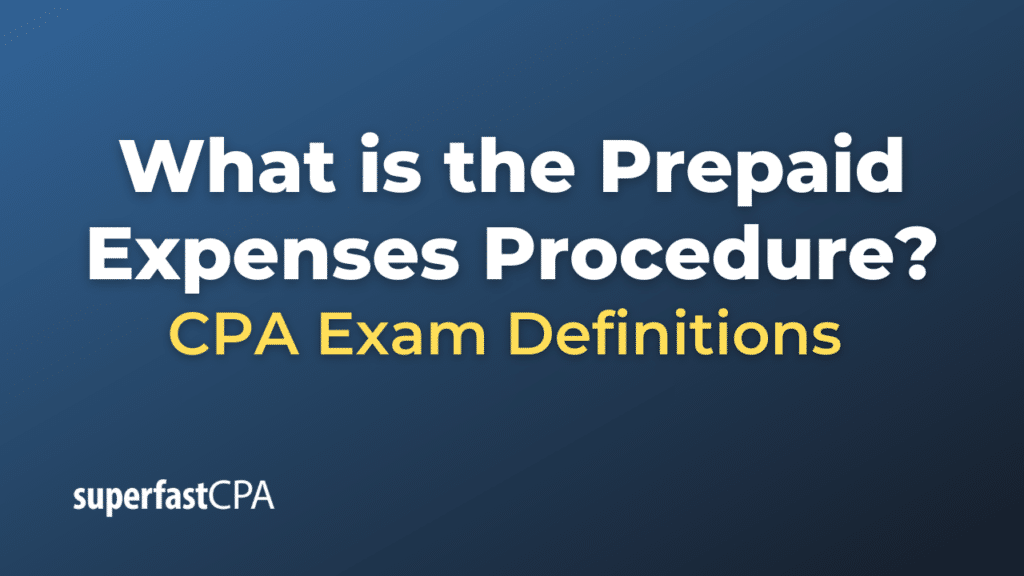Prepaid Expenses Procedure
The prepaid expenses procedure refers to the series of steps a company follows to account for expenses paid in advance. Here’s a typical procedure:
- Payment for Goods or Services in Advance: The company makes an upfront payment for goods or services that it will receive or use in the future. For example, a business may pay in advance for a one-year rental of office space.
- Recording the Prepaid Expense: The company records this upfront payment as a prepaid expense. This involves a debit to a prepaid expenses account and a credit to the cash account. The prepaid expense is recorded as a current asset on the company’s balance sheet.
- Periodic Amortization of the Prepaid Expense: As the company uses or benefits from the good or service over time, it gradually amortizes the prepaid expense. This is done by making a debit to an expense account (thus recognizing the expense on the income statement) and a corresponding credit to the prepaid expenses account (thus reducing the asset on the balance sheet). This is done periodically, usually monthly or annually.
- Tracking Prepaid Expenses: It’s important for companies to track their prepaid expenses accurately. This ensures that the correct amounts are being amortized and that the prepaid expenses account is not overdrawn.
- Year-End Adjustments: At the end of the fiscal year, companies will typically perform adjusting entries to ensure that all prepaid expenses have been properly accounted for.
- Reporting: Prepaid expenses are reported on the balance sheet as a current asset. Over time, as the prepaid expenses are amortized, this asset will decrease, and the expenses will be recognized on the income statement.
Remember that prepaid expenses procedures can vary slightly depending on a company’s specific accounting policies and the nature of its operations. But in general, the procedure aims to ensure that expenses are recognized in the period in which the benefits are received, in accordance with accrual accounting principles.
Example of the Prepaid Expenses Procedure
Let’s use an example to illustrate the prepaid expenses procedure:
Consider a company, CleanCorp, that decides to rent a new office space. The landlord requires a payment for a full year’s rent upfront, which totals $24,000. The payment is made on January 1, 2023. Here’s how CleanCorp would follow the prepaid expenses procedure:
Step 1: Payment for the Rent in Advance On January 1, 2023, CleanCorp pays $24,000 to the landlord for a year’s worth of rent.
Step 2: Recording the Prepaid Rent CleanCorp records this $24,000 payment as a prepaid expense with the following journal entry:
Debit: Prepaid Rent $24,000
Credit: Cash $24,000
At this point, the $24,000 is shown as a current asset (Prepaid Rent) on CleanCorp’s balance sheet.
Step 3: Periodic Amortization of the Prepaid Rent Each month, CleanCorp will need to recognize a portion of the prepaid rent as an expense. Since the total prepaid rent is for 12 months, each month, CleanCorp recognizes $2,000 ($24,000 / 12 months) as a rent expense. The corresponding journal entry would be:
Debit: Rent Expense $2,000
Credit: Prepaid Rent $2,000
This process is repeated every month until the end of December 2023, at which point the full $24,000 will have been recognized as Rent Expense and the Prepaid Rent account will have a balance of $0.
Step 4: Tracking Prepaid Rent Throughout the year, CleanCorp needs to accurately track the remaining balance of the Prepaid Rent account to ensure the correct amount is being recognized each month.
Step 5: Year-End Adjustments At the end of the fiscal year, CleanCorp would perform adjusting entries, if necessary, to ensure that all prepaid rent has been properly accounted for.
Step 6: Reporting CleanCorp reports the remaining Prepaid Rent on its balance sheet as a current asset until the prepaid amount is fully amortized. As the year progresses, the asset decreases, and Rent Expense is reported on the income statement.
This process ensures that CleanCorp recognizes rent expense in the period it benefits from the use of the office space, aligning with the accrual accounting principle.













